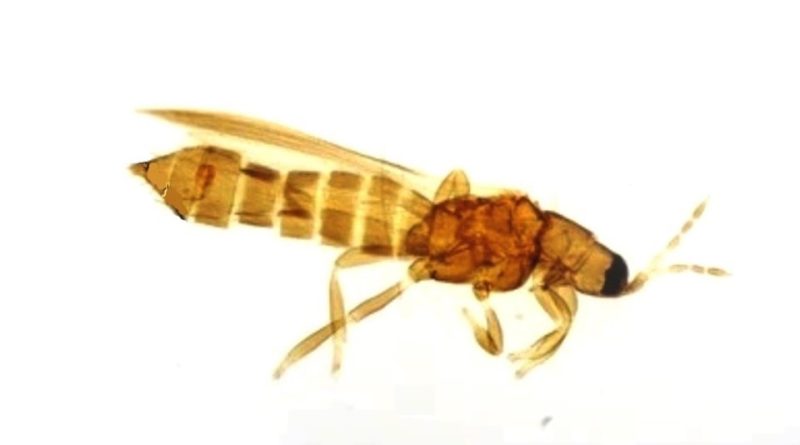Thrips meridionalis
Thrips meridionalis
The peach thrip (Thrips meridionalis, Priesner, 1926) is an insect belonging to the Thripidae family.
Systematic –
From a systematic point of view it belongs to:
Eukaryota domain,
Kingdom Animalia,
Subkingdom Eumetazoa,
Bilateria branch,
Phylum Arthropoda,
Subphylum Hexapoda,
Class Insecta,
Subclass Pterygota,
Exopterygota cohort,
Subcohort Neoptera,
Superorder Paraneoptera,
Section Thysanopteroidea,
Order Thysanoptera,
Suborder Terebrantia,
Thripidae family,
Subfamily Thripinae,
Thrips genre,
Species T. meridionalis.
The term is basionym:
– Taeniothrips meridionalis Priesner, 1926.
Geographic Distribution and Habitat –
Thrips meridionalis is an insect widespread in all European areas where it lives on peach trees and other stone fruit (apricot, cherry and plum trees); furthermore it has been reported on pear flowers and also on Erica verticillata, Iris germanica, Raphanus spp., Brassica spp. and carnation.
Morphology –
Thrips meridionalis is an insect whose adults reach 1.2-1.4 mm in length when mature.
They are dark in color with characteristic narrow, fringed wings.
The winged female is grey-brown or black-brown in color with a sometimes reddish-brown thorax.
The head is equipped with a long bristle on each side on the sides of the anterior ocellus and on the outside of which there is another about 1/3 long; behind the remaining two ocelli there are two bristles equal to the larger post-ocular ones and slightly longer than the lateral anteocellar ones.
The antennae are thin with segment I dark, II lighter, III yellow, IV dark but with a light base and remaining light or dark segments only at the joint; the VI article is shorter than the III (the latter is approximately 4 times longer than it is wide).
The pronotum has posterior corners equipped with a pair of macrochaetes.
The VIII urotergus has spinescent, comb-toothed formations regularly distributed along the entire posterior margin.
Aptitude and biological cycle –
Thrips meridionalis winters thanks to fertilized adult females, which take refuge in the soil or in the crevices of the bark of plants.
In the spring period, around the first fortnight of March which approximately corresponds to the pink button phase, the wintering adults move to the flower buds, penetrating the flowers and laying eggs inside them, using the terebra. Here, up to eighty eggs are laid, at a rate of 3-4 per day, in an isolated manner and with the terebra inside the tissues at the base of the stamens.
The nymphs are born after an incubation period of one week; they immediately feed through punctures at the base of the stamens or the tissues of the internal part of the calyx cup. The drying of the latter pushes the insect to bite the base of the style and the forming fruits.
Their presence occurs from April to May.
After two neanidal stages, one prepupal and one pupal, the new adults appear and can transfer from the peach trees to other spontaneous herbaceous or shrubby plants to continue their trophic activity.
In the spring-summer, two to three generations follow one another, the last of which gives rise to the wintering females.
Ecological Role –
Thrips meridionalis is an insect that damages the flowers and fruits of the peach tree with feeding bites; with these bites he also injects saliva, containing substances with a degenerative action which cause partial deformations and superficial lesions, which subsequently necrotise and suberify.
The fruit of nectarine peaches, due to the lack of a hairy covering, is more exposed to attack by thrips.
In fruit that is currently growing, the alterations are generally more profound and cancerous lesions can form from which a gum cirrus can emerge.
The same bites can be found on some plum cultivars.
The fight against this thysanopteran must take into account the presence of its natural enemies in the territory, among which we remember the Rhynchota Anthocoridae, especially the Orius genus which is currently being tested against greenhouse thrips.
Furthermore, the treatment period must take into account the biocenosis of other insect populations, such as pollinators, hoverflies and other insects, taking into account that chemical treatments interfere with fauna and avifauna, with the consequent alteration of birds as predators of these insects.
In this sense, crop specializations, too narrow spacing must be avoided, by applying agroecology techniques, with the presence of hedges dividing the plots (including productive ones), of intercropping (even in parallel rows) of other tree species, of specific grassing, etc.
To date, the fight against this Thrips has followed the criteria of guided struggle. Population monitoring operations are, however, rather difficult due to the characteristics of the insect to be checked; in fact, sampling must be done of very small mobile shapes that are almost never located in very precise and visible points due to their rapid movements.
In any case, the sampling, which must be done during flowering and with adequate optical instruments (magnifying glasses), is aimed at identifying the mobile forms wintering inside the floral structures, at the base of the floral whorls. Adults can be monitored by applying blue chromotropic traps (1 every 50 square metres).
Furthermore, the intervention threshold varies from species to cultivated species; for nectarines it corresponds to the presence of few mobile forms of the phytophagous.
With this type of control the intervention should be carried out at the end of flowering.
These interventions, however, can be late, especially for sensitive cultivars; in multivarietal orchards the blooms are very gradual and, having to wait for the last bloom, it arrives too late.
In the latter cases it is preferable to also carry out an intervention on the pink buttons or, better yet, during pre-flowering which has the aim of eliminating the overwintering forms and avoiding the period of greatest presence of pollinators.
Guido Bissanti
Sources
– Wikipedia, the free encyclopedia.
– GBIF, the Global Biodiversity Information Facility.
– Russo G., 1976. Agricultural Entomology. Special Part. Liguori Editore, Naples.
– Pollini A., 2002. Manual of applied entomology. Edagricole, Bologna.
– Tremblay E., 1997. Applied entomology. Liguori Editore, Naples.

